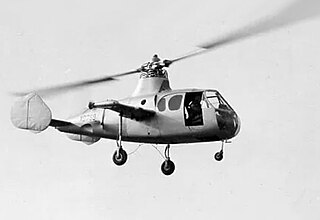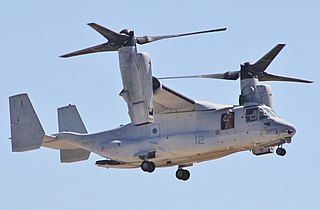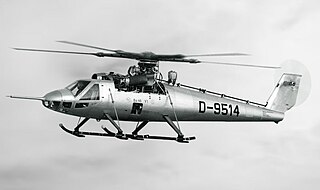The CarterCopter is an experimental compound autogyro developed by Carter Aviation Technologies in the United States to demonstrate slowed rotor technology. On 17 June 2005, the CarterCopter became the first rotorcraft to achieve mu-1 (μ=1), an equal ratio of airspeed to rotor tip speed, but crashed on the next flight and has been inoperable since. It is being replaced by the Carter Personal Air Vehicle.

The Fairey Rotodyne was a 1950s British compound gyroplane designed and built by Fairey Aviation and intended for commercial and military uses. A development of the earlier Gyrodyne, which had established a world helicopter speed record, the Rotodyne featured a tip-jet-powered rotor that burned a mixture of fuel and compressed air bled from two wing-mounted Napier Eland turboprops. The rotor was driven for vertical takeoffs, landings and hovering, as well as low-speed translational flight, but autorotated during cruise flight with all engine power applied to two propellers.

The Bell XV-15 is an American tiltrotor VTOL aircraft. It was the second successful experimental tiltrotor aircraft and the first to demonstrate the concept's high speed performance relative to conventional helicopters.

The Boeing X-50A Dragonfly, formerly known as the Canard Rotor/Wing Demonstrator, was a VTOL rotor wing experimental unmanned aerial vehicle that was developed by Boeing and DARPA to demonstrate the principle that a helicopter's rotor could be stopped in flight and act as a fixed wing, enabling it to transition between fixed-wing and rotary-wing flight.

The Lockheed AH-56 Cheyenne is an attack helicopter developed by Lockheed for the United States Army. It rose from the Army's Advanced Aerial Fire Support System (AAFSS) program to field the service's first dedicated attack helicopter. Lockheed designed the Cheyenne using a four-blade rigid-rotor system and configured the aircraft as a compound helicopter with low-mounted wings and a tail-mounted thrusting propeller driven by a General Electric T64 turboshaft engine. The Cheyenne was to have a high-speed dash capability to provide armed escort for the Army's transport helicopters, such as the Bell UH-1 Iroquois.

A tip jet is a jet nozzle at the tip of some helicopter rotor blades, used to spin the rotor, much like a Catherine wheel firework. Tip jets replace the normal shaft drive and have the advantage of placing no torque on the airframe, thus not requiring the presence of a tail rotor. Some simple monocopters are composed of nothing but a single blade with a tip rocket.

A gyrodyne is a type of VTOL aircraft with a helicopter rotor-like system that is driven by its engine for takeoff and landing only, and includes one or more conventional propeller or jet engines to provide forward thrust during cruising flight. During forward flight the rotor is unpowered and free-spinning, like an autogyro, and lift is provided by a combination of the rotor and conventional wings. The gyrodyne is one of a number of similar concepts which attempt to combine helicopter-like low-speed performance with conventional fixed-wing high-speeds, including tiltrotors and tiltwings.

The Bell XV-3 is an American tiltrotor aircraft developed by Bell Helicopter for a joint research program between the United States Air Force and the United States Army in order to explore convertiplane technologies. The XV-3 featured an engine mounted in the fuselage with driveshafts transferring power to two-bladed rotor assemblies mounted on the wingtips. The wingtip rotor assemblies were mounted to tilt 90 degrees from vertical to horizontal, designed to allow the XV-3 to take off and land like a helicopter but fly at faster airspeeds, similar to a conventional fixed-wing aircraft.

A rotorcraft or rotary-wing aircraft is a heavier-than-air aircraft with rotary wings or rotor blades, which generate lift by rotating around a vertical mast. Several rotor blades mounted on a single mast are referred to as a rotor. The International Civil Aviation Organization (ICAO) defines a rotorcraft as "supported in flight by the reactions of the air on one or more rotors".
A convertiplane is defined by the Fédération Aéronautique Internationale as an aircraft which uses rotor power for vertical takeoff and landing (VTOL) and converts to fixed-wing lift in normal flight. In the US it is further classified as a sub-type of powered lift. In popular usage it sometimes includes any aircraft that converts in flight to change its method of obtaining lift.

The Fairey Jet Gyrodyne is a British experimental compound gyroplane built by the Fairey Aviation Company that incorporated helicopter, gyrodyne and autogyro characteristics. The Jet Gyrodyne was the subject of a Ministry of Supply (MoS) research contract to gather data for the follow-up design, the Rotodyne.

The Ling-Temco-Vought (LTV) XC-142 is a tri-service tiltwing experimental aircraft designed to investigate the operational suitability of vertical/short takeoff and landing (V/STOL) transports. An XC-142A first flew conventionally on 29 September 1964, and completed its first transitional flight on 11 January 1965 by taking off vertically, changing to forward flight, and finally landing vertically. Its service sponsors pulled out of the program one by one, and it eventually ended due to a lack of interest after demonstrating its capabilities successfully.

The Sikorsky S-69 is an American experimental co-axial compound helicopter developed by Sikorsky Aircraft as the demonstrator of the Advancing Blade Concept (ABC) under United States Army and NASA funding.

A powered lift aircraft takes off and lands vertically under engine power but uses a fixed wing for horizontal flight. Like helicopters, these aircraft do not need a long runway to take off and land, but they have a speed and performance similar to standard fixed-wing aircraft in combat or other situations.

The Fairey FB-1 Gyrodyne is an experimental British rotorcraft that used single lifting rotor and a tractor propeller mounted on the tip of the starboard stub wing to provide both propulsion and anti-torque reaction.

The Bölkow Bo 46 was a West German experimental helicopter built to test the Derschmidt rotor system that aimed to allow much higher speeds than traditional helicopter designs. Wind tunnel testing showed promise, but the Bo 46 demonstrated a number of problems and added complexity that led to the concept being abandoned. The Bo 46 was one of a number of new designs exploring high-speed helicopter flight that were built in the early 1960s.

The slowed rotor principle is used in the design of some helicopters. On a conventional helicopter the rotational speed of the rotor is constant; reducing it at lower flight speeds can reduce fuel consumption and enable the aircraft to fly more economically. In the compound helicopter and related aircraft configurations such as the gyrodyne and winged autogyro, reducing the rotational speed of the rotor and offloading part of its lift to a fixed wing reduces drag, enabling the aircraft to fly faster.

The Sikorsky XV-2, also known by the Sikorsky Aircraft model number S-57, was a planned experimental stoppable rotor aircraft, designated as a convertiplane, developed for a joint research program between the United States Air Force and the United States Army. The program was cancelled before construction of the prototype began.

The Transcendental Model 1-G was an experimental American tiltrotor prototype of the 1950s. It was a single-seat aircraft powered by a single piston engine, and was the first tiltrotor to fly. A single example was built, which was destroyed in a crash in 1955.
The McDonnell 120 Flying Crane, also V-1 Jeep, was a lightweight utility flying crane helicopter designed and built by the McDonnell Aircraft Corporation during the 1950s. The open frame fuselage supported the three gas-producers and main rotor mast, with a small single-seat cockpit in the nose, which was originally open, but later enclosed.

















